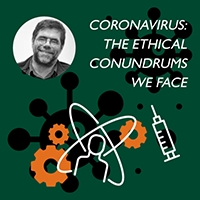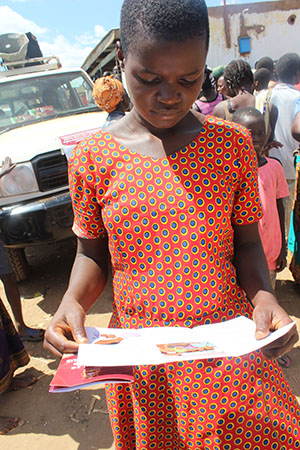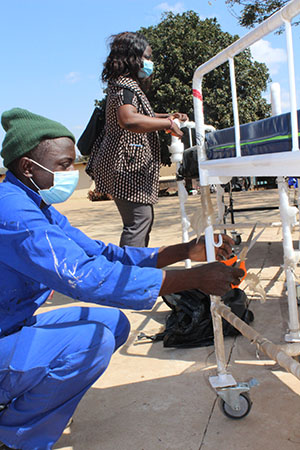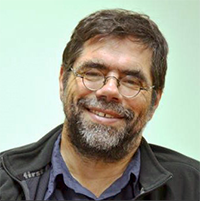Coronavirus: Los acertijos éticos que enfrentamos

![]() The controversies that COVID-19 has highlighted for us
The controversies that COVID-19 has highlighted for us
Three controversial items are addressed in this essay: intervenciones de distanciamiento social manifestadas a través de bloqueos, the challenge of providing access to intensive care units (ICUs) and ventilators, and finally the ethical issues related to the COVID-19 vaccine—especially how those in low resource settings can access vaccines. The priority of topics has changed over the course of the last six months. Early on, much was written about lockdowns and access to ICUs, whereas now access to vaccines fills newspapers and journals. This illustrates the dynamic situation in which we find ourselves.
Lockdown as an expression of social distancing

Modelling done for Malawi by the National Planning Commission (NPC) indicates both positive and negative health impacts of lockdown. The NPC explored the interaction between COVID-19, the application of social restrictions through moderate lockdowns, and the total number of societal deaths averted over the medium and long term. Lockdown aims to reduce the number of deaths in the short to medium term by restricting social interaction and social contact through school closures and movement and livelihood restrictions. A nine-month lockdown in Malawi was modelled to prevent an estimated 16,350 deaths over a five-year period. This gain is undermined by the reduced ability to provide essential health services due to health services contraction and child malnutrition. The NPC model estimates that an additional 9,950 deaths over the next five years can be attributed to the lockdown through increased mortality associated with malaria, tuberculosis, and child deaths. As a result, the total number of deaths avoided by a moderate lockdown is likely to be around 6,800. Además, the lockdown is associated with a reduction of deaths in those more susceptible to COVID-19 such as relatively older individuals while, by contrast, the additional lives lost tends to occur among younger individuals. The NPC model estimates suggest that more life years would be lost (423,000) following the implementation of lockdown restrictions compared to those gained (397,000 life years). The authors concluded, based on information available at the time (mayo 2020), eso the costs vastly outweigh the benefits of a moderate lockdown.
Infringement of individual rights and liberties has occurred in several countries during the first wave of COVID-19 and this can negatively impact pandemic control efforts. De Waal writes that Africa provides an example where a reliance on strong community engagement is preferable to a reliance on lockdown-style restrictions. Lockdown policies can only work if quasi-isolation is feasible and can be monitored and enforced—a challenge in most low-income urban areas of Africa. Además, the capacity of police to enforce lockdown is limited. These factors contribute toward large-scale evasion and subversion of lockdown measures with subsequent police and military crackdown. Multiple well-publicized images from Nairobi, Kampala, and Harare illustrated police chasing vendors off the streets with firearms and batons as they attempted to implement lockdown measures. These attempts lead to mistrust of government, which is very contrary to the established pandemic mitigation principle that relies on a strong relationship of trust between governments and their citizens for the implementation of control measures. The UN has raised the alarm that countries are ‘flouting the rule of law in the name of fighting coronavirus risk’.
The costs of lockdowns extend beyond public health control measures. Camporesi suggests that, while flattening the curve is a vital goal, other factors need to be considered, such as economic and mental health repercussions. Self-isolation and quarantine create significant physical and mental burdens for those who live alone, and the implications of economic, social, and mental health effects need to be factored into cost-benefit public health calculations. Younger generations have made huge sacrifices for older generations with little direct benefits for their own health. The closing of schools, universities, and diminished access to employment has impacted their physical and mental well-being. Además, they are saddled with the long-term debts incurred for government assistance packages in managing the pandemic. She suggests that, beyond family ties, the moral basis for this arrangement is not obvious.
Social distancing interventions at times carry a burden and certain groups may be more heavily impacted than others. Strict lockdowns that keep people at home can have very negative consequences when they need to leave their homes daily to obtain basic necessities such as food and clean water. Similarmente, school closures can impede the education of children, reduce access to food by those children who benefit from school feeding schemes, and burden working parents who are unable to provide substitute child care. Van Bruwaene et al state that, in South Africa, the background care of children has been tremendously impacted. Lockdown regulations affect children’s access to health care and education, and maternal support for hospitalized children. They note that lockdown restrictions may be considered a form of abuse or neglect. El American Academy of Pediatricians has recommended that children return to school since the academic, physical, and mental benefits outweigh the risks.
Rationing and access to care

Under conditions where the demand for intensive care outstrips supply, ‘utilitarian’ criteria can be refined. White and Lo provide useful insights about the allocation of scarce resources such as ventilators and access to critical care during the COVID-19 pandemic. Firstly, the exclusion of large groups or blocks of patients from receiving critical care such as mechanical ventilation is problematic and should be avoided. These groups include those with a higher age and/or co-morbid conditions—severe chronic lung disease, end-stage renal disease, and severe cognitive impairment. While it is understood that there is a correlation between age and mortality, it is not clear whether this is the effect of age or a reflection of the correlation between age and co-morbidities (ver Richard Horton’s comment on pandemics and syndemics).[2] Hence, a triaging decision cannot be based solely on age but rather requires an assessment of the clinically relevant facts about individuals and the likelihood of benefiting from care. Based on this reasoning it is not possible to prioritize those of a younger age over those with more advanced age.
Secondly, the idea that critical intensive care should be extended only to those most likely to survive requires further examination. While the likelihood of survival is a relevant consideration, further thought should be given to the number of years of life saved through critical care interventions such as mechanical ventilation. It is morally intuitive to select patients who stand to lose many years of life compared to patients with significant comorbidities with death likely to follow in a few years. Precedent exists for this approach under conditions of scarcity. In the United States, the allocation of lungs for transplantation includes consideration of the expected duration of survival and not only whether transplantation will prevent impending death. An additional consideration is to give individuals equal opportunity to pass through all stages of life—childhood, young adulthood, middle age, and old age. This leads to the prioritization of younger persons since they have had the least opportunity to pass through all stages of life—this excludes considerations of social worth and utility. This is known as a life-cycle principle in allocation decisions.
Thirdly, multiple criteria can be integrated into a single tool which is used to prioritize patients. All patients who meet medical indications for ICU beds are eligible and are assigned a priority score based on their likelihood of survival to discharge. This includes an objective measure of illness severity and the likelihood of achieving longer term survival based on the presence or absence of significant comorbid conditions that influence long term survival. Those individuals likely to make an active contribution to the public health response are given an increased score. Where the calculated scores between patients are equal, life-cycle considerations are used as a tiebreaker with priority accorded to younger patients. El advantage of this framework is that it does not categorically exclude large groups of patients and allows the prioritization of those most likely to benefit.
Feinstein et al suggest that the purpose of defining allocation criteria is to mitigate the worst outcomes that are likely to follow resource scarcity during a crisis. Clear policies that include transparent allocation decisions based on an explicit ethical framework should be developed. An emerging gold standard is that triage teams are established that make triaging decisions independently from frontline clinical staff. This certainly should relieve the pressure on frontline clinicians needing to make such decisions under heavy duress. The British Medical Association has outlined accessible and easily readable guidelines that include an ethical framework and thoughts about resource allocation and triage.

Access to vaccines
Vaccines raise a diversity of ethical issues. One ethical controversy is created by the use of two immortalized cell lines involved in the manufacture of vaccines. Catholic leaders and other antiabortion groups have objected to the HEK-293 cell line that was isolated from an electively aborted human embryo in the Netherlands in 1973. The other cell line, HeLa cells, is named after Henrietta Lacks, a Black tobacco farmer and mother of five from Virginia. The ethical problem originated when no consent was provided for the harvesting of her cells. Wilson, a bioethicist from Howard University, describes the problem as follows: “The use of this Black woman’s body has I think contributed to a kind of cultural memory of mistrusting health institutions among Black folks,” she says. “It’s not this one-off … it’s a larger narrative of disrespecting Black patients, using Black people and Black bodies in experiments.” The two cell lines and the underlying ideas associated with them (abortion and race) are especially topical—especially in the current lead up to the US Presidential elections.
Another ethical controversy occurs when vaccines are prematurely rushed into testing. En 2020, the National Institutes of Allergy and Infectious Diseases proceeded to test the experimental vaccine mRNA-1273 in healthy research participants without safety data gathered through preclinical animal studies. Se trata de contrary to the standard practice of initiating human studies only after data about serious side effects and the establishment of an immune response to the disease in question become available from animal studies.
Sin embargo, based on the global footprint of MSH and the populations it serves, the most serious ethical issue from our perspective is probably that of ensuring universal access to one or more of the emerging COVID-19 vaccines. Barugahare and Lie refer to the question of equitable access to a COVID-19 vaccine as a ‘litmus test’ for morality in global health governance. The questions raised are firstly, who will pay for vaccines for developing nations and secondly, who is first in line to access the vaccine and who gets relegated to the back of the queue? The problem of resource scarcity is resolved by clarifying the moral obligations of rich countries to support low-income countries to access vaccines. Priority access to the vaccine at a global scale calls for the clarification of the legitimate limits of nationalism in relation to global public health emergencies.
In terms of resource scarcity, Barugahare and Lie make two points. Firstly, one solution is through the establishment of COVID-19 vaccine financing mechanisms (Coalition for Epidemic Preparedness Innovations, and the Gavi Covax Advance Market Commitment) aimed at subsidizing vaccines for low-income countries. Secondly, symbolically it is important that low-income countries contribute a proportionate share of financial resources toward acquiring the vaccine.
Priority access to a vaccine can be considered on the basis of need. Within a particular country, health workers and those most vulnerable should be accorded priority. If we extrapolated the ‘need criterion’ internationally, the argument can be made that developing countries should be prioritized due to the lower numbers of health workers, the greater impact of non-COVID-19 disease, and the catastrophic economic consequences of extended lockdowns on susceptible populations. While the ‘need criterion’ may be viewed as the moral ideal it is unlikely to be a practical approach. Countries who manufacture and procure vaccine are likely to serve their citizens first, especially if they have invested heavily to manufacture or procure. This leads to a perspective that the best equitable access to a vaccine is based on fair global distribution after the ‘first country’ has had an opportunity to vaccinate its citizens.
This approach still does not fully resolve the issue of how best to distribute available vaccines between those with the capacity to manufacture and procure and those without this capacity. Or, as Barugahare and Lie put it: ‘how much impartiality can we reasonably demand?’ They propose the idea of ‘incremental quotas.’ This system prioritizes segments of populations (health workers, the elderly, and those with underlying conditions) who will get first access to scarce supplies of vaccines. Once these defined groups are covered in a particular country (el ‘first country’), vaccines are prioritized toward similar groups in other countries, including lower income countries. The second round or quota follows when all countries have received a first round of vaccines. This approach would make it morally tolerable for wealthier countries who have invested into vaccine development to have priority access to vaccines and is preferable to the other alternative where wealthy countries hoard vaccine supplies for themselves. This approach would allow health workers and senior citizens with underlying medical conditions in less well-resourced countries to access vaccines before the healthy youth in rich countries. The authors conclude that this approach, especially for the fair-minded, ‘should not be too much to ask.’
WHO constituted a Strategic Advisory Group of Experts on Immunization (SAGE) to develop a Values Framework for global guidance on the allocation of COVID-19 vaccines between countries, and the prioritization of groups for vaccination within countries until sufficient supplies become readily available. The Framework guides the goal of vaccine deployment and contains six core principles and 12 objectives aimed at guiding distribution. The overarching goal views COVID-19 vaccines as a global public good with the intent of contributing significantly to ‘the equitable protection and promotion of human well-being among all people of the world’. The six core principles include human well-being, equal respect, global equity, national equity, reciprocity (‘Honor obligations of reciprocity to those individuals and groups within countries who bear significant additional risks and burdens of COVID-19 response for the benefit of society’), and legitimacy (make decisions about vaccine allocation and vaccine prioritization through ‘transparent processes that are based on shared values, best available scientific evidence, and appropriate representation and input by affected parties’). The starting point for allocation and prioritization decisions remains the science of the pandemic and the measures available to control it. Sin embargo, public health considerations and economic considerations, although intricately linked, are insufficient for guiding the deployment of the vaccine. Attention needs to be paid to the devastating impact on aspects of social and individual life. Vaccine deployment should consider how vaccines can make a difference in groups of people and how the lives of those groups could be improved as a result. El Values Framework enables decision-makers to assess competing demands while reducing the likelihood of overlooking morally important issues. In a similar vein, a group has developed a ‘Fair Priority Model’, which provides a framework for ‘reconciling competing values.’
Final comments
I believe that this selection of ethical topics described above will resonate with many people. COVID-19 has touched all of us whether we live in rich and prosperous countries or less well-resourced countries. A number would have experienced the consequences of lockdowns although we in Malawi never experienced this phenomenon since the introduction was blocked by the High Court. Many are concerned about family members with advanced age and co-morbidities, and are likewise concerned about the impact of infection by coronavirus and the ability of the health system to provide care, especially in many of the countries where MSH works. Some of these topics will resonate into the future, especially for those who work closely with vaccine access initiatives and the challenges this will bring including the need to address the issue of ‘vaccine hesitancy.’
Sin embargo, as MSH we are actively engaged in many countries in COVID-19 pandemic control efforts. As we continue to drill down from the commonly cited ethical issues, it is good to explore further questions. Since MSH is a global player, it is helpful to examine those ethical concepts that may apply to MSH and other international institutions. Why do we do what we do? Are there clear ethical limits that we can apply to our actions in countries?
[1] The British Medical Association describes utilitarian in the following way ‘There has always been an ethical tension in medicine between a doctor’s concern for the health and welfare of the individual patient and concern for the health of populations. In dangerous pandemics the ethical balance of all doctors and health care workers must shift towards the utilitarian objective of equitable concern for all – while maintaining respect for all as “ends in themselves” ’. https://www.bma.org.uk/media/2226/bma-COVID-19-ethics-guidance.pdf
[2] Richard Horton further advances the interaction between COVID-19 and NCD and how this reflects a syndemic rather than a pandemic. A syndemic approach highlights biological and social interactions that impact prognosis, treatment, and health policy. He suggests that two categories of disease are interacting within specific populations—those infected by SARS-CoV-2 and those with NCDs. These conditions cluster in social groups following existing patterns of inequality that exist in societies. The implication is that if we effectively want to tackleSARS-CoV-2, we need to tackle the issue of NCDs and socioeconomic inequality. https://www.thelancet.com/journals/laninf/article/PIIS1473-3099(20)30180-8/fulltext
SOBRE EL AUTOR
 Dr. Rudi Thétard, a physician and South Africa native, has more than two decades’ experience leading complex programs in Africa, including the current $93 million USAID Malawi ONSE Health Activity (2016-21), el $20 million USAID African Strategies for Health Project (2011-16), USAID’s Basic Survival for Institutionalizing Child Survival (BASICS III, 2007-11) in Malawi (which supported Malawi in becoming one of the few African countries to achieve MDG 4), and the Malawi Reducing Childhood Morbidity and Strengthening Healthcare Systems Project (2005-07). Dr. Thétard served for eight years as a district Medical Officer in South Africa, gerente 28 fixed and mobile primary health care clinics, and has throughout his career collaborated effectively with USAID and a wide range of governmental, civil society, and implementing partners. He earned an MPH from the Prince Leopold Institute of Tropical Medicine (Bélgica) and bachelor’s degrees in medicine and surgery from the University of Stellenbosch (Sudáfrica).
Dr. Rudi Thétard, a physician and South Africa native, has more than two decades’ experience leading complex programs in Africa, including the current $93 million USAID Malawi ONSE Health Activity (2016-21), el $20 million USAID African Strategies for Health Project (2011-16), USAID’s Basic Survival for Institutionalizing Child Survival (BASICS III, 2007-11) in Malawi (which supported Malawi in becoming one of the few African countries to achieve MDG 4), and the Malawi Reducing Childhood Morbidity and Strengthening Healthcare Systems Project (2005-07). Dr. Thétard served for eight years as a district Medical Officer in South Africa, gerente 28 fixed and mobile primary health care clinics, and has throughout his career collaborated effectively with USAID and a wide range of governmental, civil society, and implementing partners. He earned an MPH from the Prince Leopold Institute of Tropical Medicine (Bélgica) and bachelor’s degrees in medicine and surgery from the University of Stellenbosch (Sudáfrica).




Respuestas